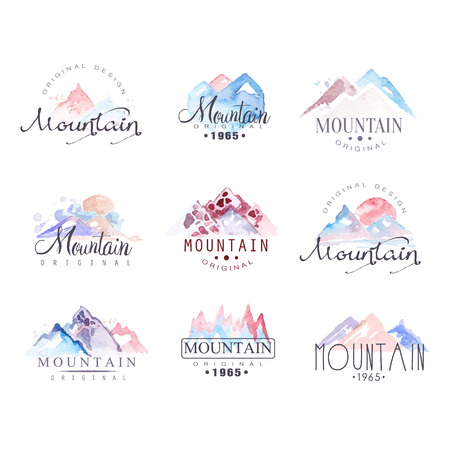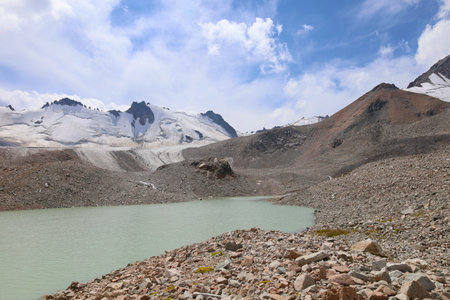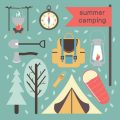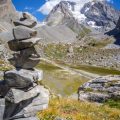Introduction to Mount Rainier National Park
Mount Rainier National Park is a crown jewel of the Pacific Northwest, drawing campers and outdoor lovers from across the country. Located in west-central Washington state, this iconic park is about a two-hour drive southeast of Seattle, making it an easy getaway for city dwellers and travelers alike. The park is centered around Mount Rainier itself—a massive active stratovolcano rising 14,410 feet above sea level and visible for miles on clear days.
What makes Mount Rainier National Park truly special is its blend of alpine meadows bursting with wildflowers, ancient forests, crystal-clear rivers, and more than 25 major glaciers—the largest single-peak glacial system in the contiguous United States. These diverse landscapes offer endless opportunities for camping adventures, whether you’re pitching a tent in a developed campground or heading deep into the backcountry.
Campers flock here not just for the breathtaking views but also for the chance to experience classic Pacific Northwest wilderness. The park’s unique combination of accessible amenities and rugged terrain means there’s something for every kind of camper—from families seeking scenic drives and cozy campsites to hardcore trekkers chasing high-elevation trails and starry nights far from civilization.
Why Mount Rainier Is a Bucket-List Camping Destination
| Feature | What Makes It Special |
|---|---|
| Alpine Meadows | Seasonal wildflower displays create vibrant, photo-worthy scenery each summer. |
| Glaciers | Home to over two dozen named glaciers—perfect for those fascinated by geology and dramatic landscapes. |
| Backcountry Treks | Miles of remote trails lead to hidden lakes, waterfalls, and panoramic mountain views. |
| Diverse Campgrounds | Options range from drive-in campgrounds with facilities to primitive sites only reachable by hiking. |
| Wildlife Watching | Spot elk, marmots, black bears, and mountain goats in their natural habitat. |
| Stargazing | The high elevation and low light pollution make for incredible night skies. |
Fast Facts About Mount Rainier National Park
| Fact | Details |
|---|---|
| Location | Pierce County, Washington (about 60 miles southeast of Seattle) |
| Established | 1899 (fifth national park in the U.S.) |
| Main Attraction | Mount Rainier (14,410 ft), highest peak in Washington State |
| Total Area | 236,381 acres (over 370 square miles) |
| Main Campgrounds | Mowich Lake, Cougar Rock, Ohanapecosh, White River (plus many backcountry options) |
| Best Time to Visit for Camping | Late June through September (snow-free at most campgrounds and trails) |
Whether you’re looking for wildflower meadows at Paradise, glacier hikes near Sunrise, or peaceful forests along the Carbon River, Mount Rainier National Park delivers an unforgettable camping experience that belongs on every outdoor lover’s bucket list.
2. Camping Options: Developed Campgrounds and Permits
Mount Rainier National Park is a camping paradise, offering everything from classic family campgrounds to remote backcountry sites for the adventurous. Here’s what you need to know about your options, whether you’re planning ahead or rolling in last-minute.
Developed Campgrounds: Reservable and First-Come, First-Served
The park features several developed campgrounds that cater to both tent campers and RVs (note: there are no hookups). Some sites can be reserved in advance, while others are only available on a first-come, first-served basis. Here’s a quick breakdown:
| Campground | Location | # of Sites | Reservations | Season |
|---|---|---|---|---|
| Cougar Rock | Southwest (near Paradise) | 173 | Reservable (recreation.gov) | Late May–late Sept |
| Ohanapecosh | Southeast corner | 188 | Reservable (recreation.gov) | Late May–late Sept |
| White River | Northeast (near Sunrise) | 112 | First-come, first-served only | Late June–late Sept |
| Mowich Lake (primitive) | Northwest (gravel road access) | 10+ walk-in sites | First-come, first-served only | Early July–early Oct (weather permitting) |
Tip: Summer weekends fill up fast! If you want a reservable site, book early through recreation.gov. For first-come spots, try to arrive before noon.
Frontcountry vs. Backcountry Camping: What’s the Difference?
Frontcountry Camping
This means car camping in one of the park’s developed campgrounds. You’ll have basic amenities like restrooms, picnic tables, and fire rings. No showers or electric hookups are available. Perfect for families or those looking for easy access.
Backcountry Camping
If you crave solitude and adventure, backcountry camping is the way to go. You’ll hike into wilderness zones and set up camp far from roads and crowds—think wildflower meadows and star-filled skies. Backcountry campsites are limited and require a permit.
The Permit Process: What You Need to Know
Developed Campground Permits/Reservations:
- If reservable: Book online at recreation.gov up to 6 months ahead.
- If first-come, first-served: Pay at the campground kiosk when you arrive; bring cash or a credit card.
- No separate permit needed for car camping beyond your campsite fee.
Backcountry Permits:
- A permit is required for all overnight backcountry trips.
- You can apply online for a wilderness permit lottery (March 15–April 30) or try for walk-up permits at park ranger stations during summer.
- Your permit will specify which camp area(s) you can use each night—this helps protect the fragile alpine environment.
- More info here from the NPS website.
Main Takeaways:
- If you want a guaranteed spot in summer, reserve early!
- If you’re backpacking, always secure your permit before heading out on the trail.
- Mowich Lake is great for primitive camping but has very limited services—be prepared to pack everything in and out.

3. Alpine Meadows and Wildflower Blooms
Mount Rainier National Park is famous for its breathtaking alpine meadows bursting with wildflowers each summer. If you’re camping in the park, exploring these vibrant fields is a must-do experience. The best wildflower displays are typically found at higher elevations, and timing your visit just right makes all the difference.
Best Time to See Wildflowers
Wildflowers usually peak between mid-July and early August, depending on snowmelt and weather conditions. Some years, blooms may arrive earlier or last into late August, especially in shadier or higher areas.
Top Wildflower Viewing Spots Near Campgrounds
| Meadow Location | Nearby Campground | Best Time to Visit | Highlights |
|---|---|---|---|
| Paradise Meadows | Cougar Rock Campground | Mid-July to Early August | Massive fields of lupine, paintbrush, and avalanche lilies; paved trails for easy access |
| Sunrise Meadows | White River Campground | Late July to Early August | Sweeping mountain views, subalpine daisies, and magenta paintbrush; great for sunrise hikes |
| Grove of the Patriarchs Area | Ohanapecosh Campground | Late July to Mid-August | Lush ferns, mossy forests, and unique lower-elevation wildflowers; family-friendly strolls along the river |
| Mowich Lake Meadows | Mowich Lake Campground (walk-in only) | Late July to Early August | Peaceful alpine setting, bear grass blooms, and fewer crowds; perfect for backcountry explorers |
Tips for Exploring Mountain Meadows
- Stay on Marked Trails: Protect delicate plants by sticking to established paths.
- Start Early: Mornings offer quieter trails and soft sunlight for photos.
- Bring Binoculars: Spot marmots, deer, and even mountain goats roaming the meadows.
- Pack Layers: Weather can change quickly at higher elevations—even in summer!
- No Picking Flowers: Help preserve the park’s beauty for future campers.
The Magic of Mount Rainier’s Wildflower Season
Catching the wildflower bloom in Mount Rainier National Park is truly magical—imagine waking up in your tent and stepping out into a world painted with color. No matter which campground you choose, you’ll find unforgettable meadows nearby waiting to be explored.
4. Glaciers and Snow-Capped Adventures
Mount Rainier National Park is famous for its breathtaking glaciers and snowy peaks. Camping here gives you front-row access to some of the most impressive ice formations in the United States. But exploring these frozen wonders safely takes a bit of planning and know-how.
Tips for Safely Viewing Mount Rainier’s Glaciers
- Stay on Designated Trails: Glacier overlooks are marked for safety—don’t venture off-path, as crevasses and unstable snow can be dangerous.
- Check Trail Conditions: Weather changes fast on the mountain. Before heading out, check the National Park Service website or ask a ranger about current trail and glacier viewing conditions.
- Keep Your Distance: Glaciers may look stable, but they’re always moving. Stay behind safety barriers and never climb onto the ice unless you’re with a certified guide.
- Dress for the Weather: Even in summer, it can get chilly near glaciers. Bring layers, including a waterproof jacket, gloves, and a warm hat.
What to Pack for Glacier Adventures
| Item | Why You Need It |
|---|---|
| Layered Clothing | Weather can change rapidly; stay warm and dry |
| Sunscreen & Sunglasses | Snow and ice reflect sunlight—protect your skin and eyes |
| Sturdy Hiking Boots | Trails can be rocky or slippery near glaciers |
| Trekking Poles | Add stability on uneven terrain |
| Daypack with Snacks & Water | You’ll want energy and hydration while exploring |
| Camera or Smartphone | Capture those epic views! |
| Pocket Map or GPS Device | Avoid getting lost—cell service is spotty in the park |
Guided Activities for Campers Near Glaciers
- Ranger-Led Hikes: Join a free ranger-guided walk for expert insight into Mount Rainier’s glacial landscapes (check schedules at park visitor centers).
- Snowshoe Tours: In winter or early spring, guided snowshoe hikes offer a safe way to experience snowy meadows and get close to the glaciers without special gear.
- Photography Workshops: Some local outfitters run photo tours focused on capturing Mount Rainier’s icy beauty—perfect for beginners and shutterbugs alike.
- Glacier Viewpoints: Popular spots like Paradise, Sunrise, and Emmons Vista offer easy-access glacier views ideal for families or anyone wanting an unforgettable picnic backdrop.
A Few Extra Tips from Locals:
- Mornings often have clearer skies—plan your glacier adventure early for better visibility.
- If you hear cracking or shifting ice, move away from glacier edges immediately.
- Packed-out snacks taste even better with a view of Nisqually Glacier!
5. Backcountry Treks and Trail Highlights
Mount Rainier National Park is a paradise for backpackers looking for epic backcountry adventures. Whether you’re seeking a multi-day trek or a day-long escape, the park offers a range of trails that showcase its alpine meadows, glaciers, and old-growth forests. Here’s what you need to know to plan your next backcountry camping trip at Mount Rainier.
Essential Routes for Backpackers
| Trail Name | Mileage (One Way) | Difficulty | Highlights |
|---|---|---|---|
| Wonderland Trail | 93 miles (loop) | Strenuous | 360° views of Mount Rainier, multiple ecosystems, river crossings |
| Naches Peak Loop | 3.5 miles | Easy/Moderate | Wildflowers, alpine lakes, panoramic vistas |
| Spray Park Trail | 6 miles (one way) | Moderate/Strenuous | Meadows in bloom, waterfall views, glacier scenery |
| Burroughs Mountain Trail | 9 miles (round trip) | Strenuous | Breathtaking views of Emmons Glacier and summit views of Rainier |
Wonderland Trail Insights
The Wonderland Trail is the crown jewel of Mount Rainier backcountry treks. Circling the entire mountain for 93 miles, this trail takes you through lush valleys, subalpine meadows, and past roaring rivers fed by ancient glaciers. Most hikers take 9–14 days to complete the full loop, camping at designated sites along the way. Permits are required and can be competitive—plan ahead and enter the lottery early in spring. Pro tip: Pack light and be ready for sudden weather changes!
Route Planning Advice
- Pace Yourself: Elevation gains are significant; plan shorter mileage days if you’re new to altitude.
- Campsite Reservations: Book your wilderness permits online as soon as they become available.
- Water Sources: Streams are plentiful but always treat or filter your water before drinking.
- Navigation: Carry a map and compass or download offline maps—cell service is unreliable.
- Bears & Wildlife: Use bear canisters or hang food in provided storage areas at campsites.
Leave No Trace Principles in the Backcountry
- Pack It In, Pack It Out: Take all trash—including food scraps—back with you.
- Campsite Selection: Use established campsites to minimize your impact on fragile meadows.
- Stay on Trails: Help prevent erosion by sticking to marked paths even when muddy or snow-covered.
- Respect Wildlife: Observe animals from a distance and never feed them.
- Sustainable Fires: Campfires are not allowed in most backcountry areas; bring a stove for cooking.
Your Adventure Awaits!
No matter which trail you choose, exploring the backcountry of Mount Rainier National Park promises unforgettable scenery and true solitude. Plan ahead, respect nature, and enjoy every mile of these legendary routes.
6. Wildlife, Safety, and Park Etiquette
Respecting Mount Rainier’s Wildlife
Mount Rainier National Park is home to black bears, elk, marmots, mountain goats, and countless birds. When camping or hiking here, always observe wildlife from a safe distance. Feeding animals—even squirrels—can harm them and is against park regulations.
Bear Canister Requirements
Bears are active in the park, so proper food storage is a must. The National Park Service requires that all campers use approved bear canisters or hang their food at least 10 feet off the ground and 4 feet away from any tree trunk. Never leave food unattended at your campsite or picnic area.
| Item | Requirement |
|---|---|
| Bear Canister | Required for all backcountry camping |
| Food Storage | Store all scented items (food, toiletries) in canisters or hang bags properly |
| Garbage Disposal | Pack out all trash—leave no trace! |
Campfire Rules and Fire Safety
To protect the fragile alpine environment, campfires are only allowed in designated fire rings at certain front-country campgrounds. In most backcountry areas, fires are prohibited—use portable stoves for cooking instead. Always check current fire bans before your trip.
| Area Type | Campfire Policy |
|---|---|
| Front-Country Campgrounds (e.g., Cougar Rock) | Allowed in established fire rings only |
| Backcountry Sites | No campfires permitted—use stoves only |
| PICNIC AREAS | Check signs for specific rules; never leave fires unattended |
Staying Safe in Changing Mountain Weather
The weather on Mount Rainier can change quickly—from sunny skies to rain or even snow within hours. Always pack layers: a waterproof jacket, warm hat, gloves, and extra socks are essential year-round. Before heading out, check the latest weather forecast and trail conditions at a ranger station or online.
Quick Tips for Mountain Safety:
- Stay Hydrated: Bring enough water or use a filter for natural sources.
- Avoid Hiking Alone: If solo, let someone know your route and expected return time.
- Cary a Map & Compass: Don’t rely solely on cell service or GPS—it’s spotty in the park.
- Watch for Signs of Hypothermia: Shivering, confusion, and fatigue mean you should get warm fast.
- If Thunderstorms Approach: Leave open meadows and ridges immediately; seek lower ground.
Park Etiquette: Leave No Trace Principles
The beauty of Mount Rainier depends on every camper doing their part. Stick to trails to avoid trampling delicate wildflowers in the meadows, pack out everything you bring in (including food scraps), and be considerate of other visitors by keeping noise levels down. Following these simple guidelines ensures everyone can enjoy this incredible national park for years to come.
7. Planning Your Rainier Camping Experience
Checklist for a Smooth Adventure
When it comes to camping in Mount Rainier National Park, planning ahead is the key to an unforgettable trip. From reserving permits to packing the right gear, every detail counts. Here’s your go-to checklist:
| What You Need | Tips & Details |
|---|---|
| Camping Permits | Check Recreation.gov for site availability and reserve early, especially for peak summer weekends. |
| Packing List | Layered clothing, waterproof boots, rain jacket, food, stove or bear canister (required in some areas), first aid kit, map/compass/GPS. |
| Essential Gear | Tent with rainfly, sleeping bag rated for mountain temps, sleeping pad, headlamp or flashlight with extra batteries. |
| Bear Safety Items | Bear spray (know how to use it!), food storage container or hang kit. |
| Backcountry Permit (If Hiking Overnight) | Apply online as far in advance as possible; a limited number are available for walk-ins at ranger stations. |
| Maps and Trail Guides | Download or pick up at park entrance; cell service is spotty, so don’t rely on your phone. |
| Local Resources | Visit the Longmire Wilderness Information Center or Paradise Visitor Center for trail updates and weather conditions. |
| Leave No Trace Supplies | Packed trash bags, biodegradable soap, trowel for digging catholes if required. |
Permit Reservations: What to Know
You’ll need a permit for both frontcountry campsites (like Cougar Rock and Ohanapecosh) and backcountry wilderness camping. Permits can be reserved online, but walk-up permits are sometimes available on a first-come, first-served basis at ranger stations. Always double-check reservation windows and seasonal opening dates—the park’s snowpack can delay access well into June or July.
Packing Tips for Rainier’s Unique Climate
- Prepare for unpredictable weather: It can be sunny one minute and raining the next—layers are your best friend!
- Packs get heavy fast: Stick to essentials but don’t skimp on warmth or rain protection.
- If you’re hiking above treeline: Bring sunblock and sunglasses—glare off glaciers is no joke.
- Bears are active in summer: Use only approved storage methods for all scented items.
Where to Find Local Help
If you need last-minute supplies or advice, stop by Ashford (the gateway town just outside the park) for outdoor stores and rental shops. The staff at Mount Rainier National Park’s visitor centers are always ready with maps, current trail info, and safety tips specific to your route.


